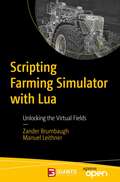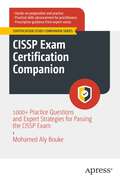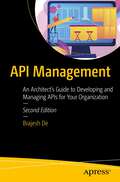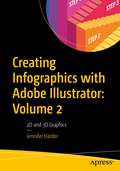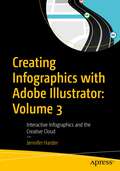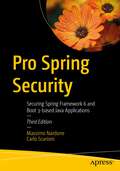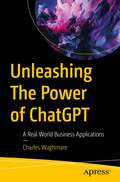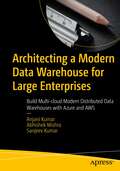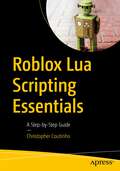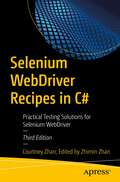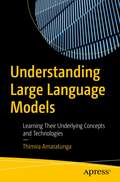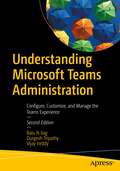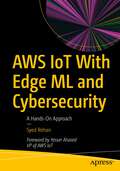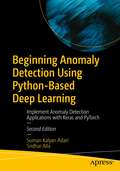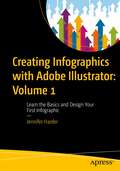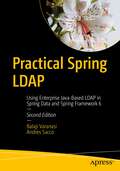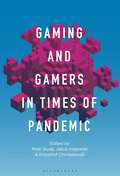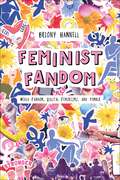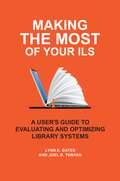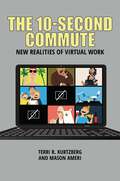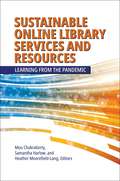- Table View
- List View
Scripting Farming Simulator with Lua: Unlocking the Virtual Fields
by Zander Brumbaugh Manuel LeithnerCreate mods using the popular game Farming Simulator with Lua, a versatile scripting language that can run on various platforms and applications. This open access book is best suited for programmers who want to learn how to use Lua to write scripts that can enhance and extend the gameplay experience.You'll start by reviewing the basics of programming in Lua and then move on to advanced topics, such as object-oriented programming, vehicle and placeable specializations, network synchronization, and creating custom user interfaces. With step-by-step instructions and detailed explanations, you'll see how to create scripts that modify game mechanics and add new features to the game.The practical examples and projects are ideal for providing hands-on experience with Lua scripting. Whether you are a creator looking to take your skills to the next level or a game developer interested in learning a new programming language, Scripting Farming Simulator with Lua is the ultimate guide to mastering Lua scripting.What You'll LearnUnderstand the fundamentals of programming in LUAImplement a basic “Hello-World” modAdd a new graphical user interface to your modUse hook scripts to extend base game featuresPublish your mod on the official Farming Simulator ModHub Who This Book Is ForCreators who want to add new features to Farming Simulator; game developers who want to learn a new programming language for modding purposes, and anyone who wants to expand their knowledge of programming and scripting.
CISSP Exam Certification Companion: 1000+ Practice Questions and Expert Strategies for Passing the CISSP Exam (Certification Study Companion Series)
by Mohamed Aly BoukeThis is a comprehensive guide for individuals preparing for the Certified Information Systems Security Professional (CISSP) exam. The book's main focus is to provide readers with a wealth of practice questions and expert tips to help them pass the CISSP exam.The demand for certified information security professionals continues to increase, and the CISSP exam is widely recognized as one of the most challenging and comprehensive information security certification exams. This book will provide readers with the practice and exam strategies they need to pass the CISSP exam and launch their careers in information security. It covers all of the topics tested on the exam, including security management practices, access control systems and methodology; laws, regulations, standards, and compliance; and telecommunications and network security.In addition to providing practice questions, this book also includes background information on the CISSP exam, including the exam format, content, and best ways to study for the exam. It is designed to be user friendly and easy to follow, with clear explanations and examples for all the practice questions.What You Will LearnGain a comprehensive understanding of the CISSP Common Body of Knowledge (CBK)Gain background information on the CISSP exam, including the exam format, content, and best ways to study for the examDevelop the critical thinking skills that are essential for success on the CISSP examMaster test-taking strategies for successfully passing the CISSP examPrepare through a realistic simulation of the actual CISSP examWho this book is for:Individuals preparing for the Certified Information Systems Security Professional (CISSP) exam—someone who has a background in information technology or information security and is looking to pass the CISSP exam and become a CISSP-certified professional.Secondary audiences include information technology professionals looking to expand their knowledge and skills in the field of information security, individuals interested in pursuing a career in information security and considering the CISSP certification, and current or aspiring information security managers who want to advance their careers and take on more responsibilities in their organizations.
API Management: An Architect's Guide to Developing and Managing APIs for Your Organization
by Brajesh DeAPIs are the enablers for a thriving ecosystem that can drive revenue growth and ROIs for any organization. This book will cover all relevant topics and trends that enterprise architects need to know to build and govern APIs as a product. The second edition of the API Management builds on the foundation established in the first edition to cover recent advances in API development as well as the principles and best practices of building API as a product. It has been updated to cover the latest and emerging trends in API architecture, design, and implementation covering the use of gRPC, graphQL, microservices and service mesh to building and manage a scalable API platform. New chapters cover how to build an effective API strategy for digital transformation and implement an API-First architecture to build and deliver APIs as a Product. Any software architect or developer looking to adopt and build APIs for digital transformation and excellence within their organization will find this book to be an invaluable resource. What You Will Learn Understand API Management Architecture and Design best practices How to build an effective API strategy and build APIs as product How to design, build and test APIs using API-First approach How to implement API Security What are the latest API technology trends and adoption across industry Who This Book Is For CxOs, software architects, and developers who are looking to implement APIs within their organization for digital transformation initiatives.
Creating Infographics with Adobe Illustrator: 2D and 3D Graphics
by Jennifer HarderThis full-color book will teach you how to use Adobe Illustrator's various tools to create infographics, as well as basic page layouts for them. It focuses on Illustrator’s powerful graphing tools and 2D and 3D effects. How can an infographic or graph be altered and adapted to appear more engaging and still display your data accurately? What additional effects can be used on your infographic to produce the results you envision? In this second volume of Creating Infographics with Adobe Illustrator, you will learn the answers to all these questions. Author Jennifer Harder will walk you through creating basic infographics in Illustrator using Illustrator tools such as Graphing Tools as well as how to create 2D effects and 3D shapes with their related materials, including Symbols. Upon completing this volume, you will have an appreciation for how easy it is to design an infographic or graph to display your data and discover how rudimentary shapes and colors can be altered using patterns, as well as 2D and 3D effects, to enhance readability while conveying meaning to your audience. You will be able to use this knowledge to create your own infographics using Illustrator’s wide array of tools. What You Will Learn Use Illustrator’s Graphing Tools to create and modify basic charts or graphsWork with popular 2D effects to enhance your design in IllustratorCreate 3D Shapes using Materials and Symbols and modify your 3D GraphsExplore basic Image Trace and Perspective options in Illustrator Who This Book Is For Beginner-level designers and others who are interested in learning the process of creating infographics for their company, the classroom, for data visualization, an article in a magazine, or a webpage.
Creating Infographics with Adobe Illustrator: Interactive Infographics and the Creative Cloud
by Jennifer HarderThis full-color book, the third of three volumes, focuses on Adobe Illustrator’s SVG interactivity tools. How can an infographic be made more interactive for an audience? What additional Illustrator tools and Adobe applications can be used to enhance your infographic layout? In this final volume of Creating Infographics with Adobe Illustrator, you will learn the answers to all these questions. Author Jennifer Harder will walk you through creating basic infographics in Illustrator using Illustrator tools for creating SVG files, known as Scalable Vector Graphics, for basic Interactivity on a web page. Then you will review layouts in other Adobe Applications in relation to their connectivity with Illustrator. Upon completing this volume, you will have a thorough understanding of how to design an infographic with basic interactivity for a web page, and how this can improve visualization and convey meaning to your audience. Moreover, you will be able to use this knowledge to create your own infographics using Illustrator’s wide array of tools. What You Will Learn Discover how to apply interactivity to an infographicGain insight into different infographic layouts and how to finalize your project with your clientExplore other Adobe Creative Cloud applications that may assist you in the future as you create your infographics Who This Book Is For Beginner-level designers and others who are interested in learning the process of creating infographics for their company, the classroom, for, an article in a magazine, or adding interactivity to webpage.
Pro Spring Security: Securing Spring Framework 6 and Boot 3-based Java Applications
by Massimo Nardone Carlo ScarioniBuild and deploy secure Spring Framework and Spring Boot-based enterprise Java applications with the Spring Security Framework. This book explores a comprehensive set of functionalities to implement industry-standard authentication and authorization mechanisms for Java applications.Pro Spring Security, Third Edition has been updated to incorporate the changes in Spring Framework 6 and Spring Boot 3. It is an advanced tutorial and reference that guides you through the implementation of the security features for a Java web application by presenting consistent examples built from the ground up.This book also provides you with a broader look into Spring security by including up-to-date use cases such as building a security layer for RESTful web services and JSON Web Token applications.What You Will LearnExplore the scope of security and how to use the Spring Security FrameworkMaster Spring security architecture and design Secure the web tier in Spring Work with alternative authentication providersTake advantage of business objects and logic securityExtend Spring security with other frameworks and languagesSecure the service layerSecure the application with JSON Web TokenWho This Book Is ForExperienced Spring and Java developers with prior experience in building Spring Framework or Boot-based applications
Unleashing The Power of ChatGPT: A Real World Business Applications
by Charles WaghmareExplore the role ChatGPT can play in business, including operations, marketing, sales, and delivery. This concise book illustrates how ChatGPT is changing the way individuals interact with machines and how you can take advantage of its capabilities for business. The book starts with an overview of ChatGPT and its impact in the realm of of conversational AI. You will then dive into the technical aspects of ChatGPT and gain an understanding of how machine learning algorithms and natural language processing work in the background. Various business applications of ChatGPT are then discussed, followed by how it can get integrated into your business operations. To wrap things up, you will gain insight into the data and privacy elements that need to be considered while using ChatGPT, and how to maintain its integrity. After completing this book, you will understand the ChatGPT framework and how to integrate it into your own ventures. What You Will Learn Understand the various technologies and techniques utilized in ChatGPTGain insight into the future of human-machine interactionAnalyze the advantages and disadvantages of ChatGPT for your industryExplore the ethical implications of using AI Who This Book Is For Tech enthusiasts who are passionate about artificial intelligence (AI), machine learning, and human-machine interaction.
Architecting a Modern Data Warehouse for Large Enterprises: Build Multi-cloud Modern Distributed Data Warehouses with Azure and AWS
by Anjani Kumar Abhishek Mishra Sanjeev KumarDesign and architect new generation cloud-based data warehouses using Azure and AWS. This book provides an in-depth understanding of how to build modern cloud-native data warehouses, as well as their history and evolution. The book starts by covering foundational data warehouse concepts, and introduces modern features such as distributed processing, big data storage, data streaming, and processing data on the cloud. You will gain an understanding of the synergy, relevance, and usage data warehousing standard practices in the modern world of distributed data processing. The authors walk you through the essential concepts of Data Mesh, Data Lake, Lakehouse, and Delta Lake. And they demonstrate the services and offerings available on Azure and AWS that deal with data orchestration, data democratization, data governance, data security, and business intelligence. After completing this book, you will be ready to design and architect enterprise-grade, cloud-based modern data warehouses using industry best practices and guidelines. What You Will Learn Understand the core concepts underlying modern data warehousesDesign and build cloud-native data warehousesGain a practical approach to architecting and building data warehouses on Azure and AWSImplement modern data warehousing components such as Data Mesh, Data Lake, Delta Lake, and LakehouseProcess data through pandas and evaluate your model’s performance using metrics such as F1-score, precision, and recallApply deep learning to supervised, semi-supervised, and unsupervised anomaly detection tasks for tabular datasets and time series applications Who This Book Is For Experienced developers, cloud architects, and technology enthusiasts looking to build cloud-based modern data warehouses using Azure and AWS
Roblox Lua Scripting Essentials: A Step-by-Step Guide
by Christopher CoutinhoEmbark on a transformative journey through the exciting world of Roblox Lua scripting with this comprehensive hands-on guide. Tailored to game developers, both seasoned and new, this book serves as your roadmap to mastering the art and science of Lua scripting within the dynamic Roblox Studio environment.You'll explore a wide spectrum of foundational concepts, including variables, functions, loops, tables, arrays, and more. Delve into advanced topics like raycasting, object-oriented programming with humanoids, and intricate leaderboard systems. Each chapter is crafted with real-world examples and step-by-step tutorials, empowering you to create engaging and interactive gameplay experiences.You'll gain profound insights into modularization, efficient coding practices, and techniques to optimize your scripts, paving the way to elevate your game development to an entirely new plane of creativity and complexity. You'll also discover sophisticated scripting concepts, such as custom events, and client-server communication. Invest in your future as a Roblox developer today, and let this book be your guide to crafting extraordinary gaming experiences. Roblox Lua Scripting Essentials provides the insight, tools, and guidance needed to shape your unique path in this thrilling domain of game development. What You'll Learn Wield variables, functions, loops, conditionals, arrays, and more to create dynamic gameplay elementsExplore the principles of object-oriented programming, and modularization techniques to develop clean, efficient, and organized codeUnderstand the complex client-server relationships, custom events, and multiplayer functionalities that bring games to lifeDiscover the power of modular coding, enabling you to create more organized and maintainable code basesLay down a robust foundation in Lua scripting for Roblox Who This Book Is For This book is meticulously crafted to serve a diverse array of readers, ranging from complete beginners to intermediate developers.
Selenium WebDriver Recipes in C#: Practical Testing Solutions for Selenium WebDriver
by Courtney ZhanSolve your Selenium WebDriver problems with this quick guide to automated testing of web applications with Selenium WebDriver in C#. This third edition contains hundreds of solutions to real-world problems, with clear explanations and ready-to-run Selenium test scripts that you can use in your own projects. Updated to Selenium version 4, this revision includes Visual Studio Code set up, additional recipes, and new chapters on Selenium DevTools and continuous testing. You'll see how to use Selenium WebDriver for select lists, navigation, assertions, frames, file upload and pop-up dialogs. You'll also learn how to locate web elements and test functions for hyperlinks, buttons, TextFields and TextAreas, radio buttons, CheckBoxes, and more. What You'll Learn Debug test scripts and test data Work with Selenium Remote Control Server Manage and deal with browser profiles and capabilities Monitor tests for advanced user interactions and experiences (UX) Who This Book Is For Experienced .NET and C# Windows application programmers/developers.
Understanding Large Language Models: Learning Their Underlying Concepts and Technologies
by Thimira AmaratungaThis book will teach you the underlying concepts of large language models (LLMs), as well as the technologies associated with them. The book starts with an introduction to the rise of conversational AIs such as ChatGPT, and how they are related to the broader spectrum of large language models. From there, you will learn about natural language processing (NLP), its core concepts, and how it has led to the rise of LLMs. Next, you will gain insight into transformers and how their characteristics, such as self-attention, enhance the capabilities of language modeling, along with the unique capabilities of LLMs. The book concludes with an exploration of the architectures of various LLMs and the opportunities presented by their ever-increasing capabilities—as well as the dangers of their misuse. After completing this book, you will have a thorough understanding of LLMs and will be ready to take your first steps in implementing them into your own projects. What You Will Learn Grasp the underlying concepts of LLMsGain insight into how the concepts and approaches of NLP have evolved over the yearsUnderstand transformer models and attention mechanismsExplore different types of LLMs and their applicationsUnderstand the architectures of popular LLMsDelve into misconceptions and concerns about LLMs, as well as how to best utilize them Who This Book Is For Anyone interested in learning the foundational concepts of NLP, LLMs, and recent advancements of deep learning
Understanding Microsoft Teams Administration: Configure, Customize, and Manage the Teams Experience
by Balu N Ilag Durgesh Tripathy Vijay IreddyThis book provides solutions, best practices, tips, and workarounds to plan, design, customize, implement, and manage Microsoft Teams in any environment. This revised edition has been updated to reflect all the latest techniques and products, including migration from Skype for Business On-Prem to Microsoft Teams, along with Teams for Education, which includes a range of features and tools that enable teachers and students to collaborate, communicate, and learn in a virtual environment.The book begins with an overview of Microsoft Teams, including its architecture, teams/channels, audio/video meetings, and the phone system. The authors then take you deeper into deployment and management of teams, clients, guests and external access, and live events, followed by a walk-through of network assessment and bandwidth planning for Teams. Here, you will learn about deployment of quality of service and how to configure your phone systems using direct routing and calling plans. Moving forward, you will learn Microsoft Teams administration and policy management along with the migration process of Skype from Business On-Prem to Microsoft Teams. To wrap things up, the authors demonstrate some troubleshooting techniques for call quality issues in Teams, and walk you through various features of Teams for Education and how to utilize them. By the time you turn the last page of Understanding Microsoft Teams Administration, you'll be fully equipped to configure, customize, and control Teams with confidence. Don't just adapt to the future of collaboration—lead it. What You Will Learn Kickstart your journey: Get acquainted with the Teams architecture, from teams and channels to audio/video conferencing and beyondMaster the mechanics: Dive deep into deployment, including crucial aspects like guest access, such as events, and network assessmentElevate call quality: Learn the nuts and bolts of Quality of Service (QoS) and phone systems, including direct routing and calling plansAdmin like a pro: Gain insights into robust policy management, and understand how to navigate the Teams admin portal with finesseGet a grip on network assessment and bandwidth planning tailored specifically for TeamsUnlock secrets of quality of service, direct routing, and customized calling plansMigration simplified: Seamlessly shift from Skype for Business On-Prem to Teams without missing a beatEdu-tech unveiled: Explore Teams for Education and how its myriad features can enrich virtual learning experiences for teachers and students alikeWhat's new: A dedicated chapter exclusively covering Microsoft Teams for Education, focusing on empowering both educators and studentsWho This Book Is For Administrators and technical consultants focused on Microsoft Teams. This book serves as an invaluable resource for those looking to optimize team collaboration and communication within their organizations.
AWS IoT With Edge ML and Cybersecurity: A Hands-On Approach
by Syed RehanIn an era where the fusion of connectivity and technology is redefining industries, this book is a must-have guide for aspiring technologists and seasoned professionals alike. This meticulously crafted handbook guides you through every aspect of AWS IoT, touching upon vital spheres such as edge computing, machine learning, and industrial IoT, with a distinct spotlight on cybersecurity. Over the course of this book, industry veteran Syed Rehad unveils the secrets to setting up your AWS IoT environment and walks you through advanced concepts such as leveraging MQTT, mastering Digital Twin implementation, and plumbing the depths of edge machine learning. Whether you're experimenting with virtual devices or hands-on with Raspberry Pi setups, this book will steer you towards innovation and a transformative journey where technology meets intelligence and security, all under the expansive umbrella of AWS IoT. What You Will Learn AWS Mastery: Dive deep into AWS IoT essentials, from setup to hands-on SDK toolsAdvanced Connectivity: Explore advanced MQTT features and the potential of AWS IoT Core MQTT clientsDevice Integration: Master AWS IoT device creation, connection, and deployment, blending the digital and physicalDigital Twin: Unleash IoT's future with AWS IoT device shadow, capitalizing on digital twin technologyDevice Management: Transform remote oversight using secure IoT tunnelling and innovative actionsEdge Development: Merge IoT and Machine Learning via AWS IoT Greengrass, spotlighting image classificationData to Insights: Swiftly move from raw data to actionable insights leveraging Amazon TimestreamIoT Cybersecurity: Strengthen your defenses using AWS IoT Device Defender, Zero Trust principles, and Machine Learning (ML) Detect to prepare for and counter threats Who This Book Is For IoT developers and enthusiasts, professionals who want to implement IoT solutions in industrial scenarios, system architects and designers interested in edge machine learning, business intelligence analysts, and cybersecurity professionals.
Beginning Anomaly Detection Using Python-Based Deep Learning: Implement Anomaly Detection Applications with Keras and PyTorch
by Suman Kalyan Adari Sridhar AllaThis beginner-oriented book will help you understand and perform anomaly detection by learning cutting-edge machine learning and deep learning techniques. This updated second edition focuses on supervised, semi-supervised, and unsupervised approaches to anomaly detection. Over the course of the book, you will learn how to use Keras and PyTorch in practical applications. It also introduces new chapters on GANs and transformers to reflect the latest trends in deep learning. Beginning Anomaly Detection Using Python-Based Deep Learning begins with an introduction to anomaly detection, its importance, and its applications. It then covers core data science and machine learning modeling concepts before delving into traditional machine learning algorithms such as OC-SVM and Isolation Forest for anomaly detection using scikit-learn. Following this, the authors explain the essentials of machine learning and deep learning, and how to implement multilayer perceptrons for supervised anomaly detection in both Keras and PyTorch. From here, the focus shifts to the applications of deep learning models for anomaly detection, including various types of autoencoders, recurrent neural networks (via LSTM), temporal convolutional networks, and transformers, with the latter three architectures applied to time-series anomaly detection. This edition has a new chapter on GANs (Generative Adversarial Networks), as well as new material covering transformer architecture in the context of time-series anomaly detection. After completing this book, you will have a thorough understanding of anomaly detection as well as an assortment of methods to approach it in various contexts, including time-series data. Additionally, you will have gained an introduction to scikit-learn, GANs, transformers, Keras, and PyTorch, empowering you to create your own machine learning- or deep learning-based anomaly detectors. What You Will Learn Understand what anomaly detection is, why it it is important, and how it is appliedGrasp the core concepts of machine learning.Master traditional machine learning approaches to anomaly detection using scikit-kearn.Understand deep learning in Python using Keras and PyTorchProcess data through pandas and evaluate your model's performance using metrics like F1-score, precision, and recallApply deep learning to supervised, semi-supervised, and unsupervised anomaly detection tasks for tabular datasets and time series applications Who This Book Is For Data scientists and machine learning engineers of all levels of experience interested in learning the basics of deep learning applications in anomaly detection.
Creating Infographics with Adobe Illustrator: Learn the Basics and Design Your First Infographic
by Jennifer HarderThis full-color book will teach you how to use Adobe Illustrator's various tools to create infographics, as well as basic page layouts for them. This is the first of three volumes which will cover all the fundamentals of Illustrator, an industry standard application used by graphic designers and marketing and communication teams. How is an infographic different from a logo or any other illustration? What additional thought processes, skills, or software tools should be utilized to create an infographic? In this first volume of Illustrator Basics, you will learn the answers to all these questions. Author Jennifer Harder will walk you through creating basic infographics in Illustrator using Basic Shape tools, Pen Tools, Type Tools, and Symbols. Upon completing this volume, you will have an appreciation for how easy it is to design an infographic and discover how rudimentary shapes and colors can affect readability while conveying meaning to your audience. You will be able to use this knowledge to create your own infographics using Illustrator’s wide array of tools. Who This Book Is For Discover the tools within Illustrator that are ideal for creating basic infographicsDevelop a logo based upon a scanned sketchGain an understanding of different infographic layouts and the process of reviewing them with your client Who This Book Is For Beginner-level designers and others who are interested in learning the process of creating infographics for their company, the classroom, for a visual resume, an article in a magazine, or a webpage.
Practical Spring LDAP: Using Enterprise Java-Based LDAP in Spring Data and Spring Framework 6
by Balaji Varanasi Andres SaccoThis revised edition is your practical, hands-on guide to developing Java-based enterprise applications with big data or batches of data using the Spring LDAP and the Spring Data LDAP frameworks. The book covers these popular Spring project modules and explains the purpose and fundamental concepts of LDAP before giving a comprehensive tour of the latest version of Spring LDAP and Spring Data LDAP as found in Spring Framework 6. The book provides a detailed treatment of LDAP controls and the new features of Spring LDAP such as Object Directory Mapping and LDIF parsing. LDAP has become the de facto standard for storing and accessing information in enterprises. Despite its widespread adoption, developers often struggle when it comes to using this technology effectively. The traditional Java LDAP and JNDI approaches have proven to be painful and have resulted in complex, less modular applications. The Spring LDAP framework provides an ideal alternative.After reading and using this book, you'll come away with a level of comfort for working with large batches of data or big data in your enterprise Spring applications development.What You'll LearnExplore "What is Java LDAP?" and understand the Spring LDAP and Spring Data LDAP frameworksSearch LDAP resourcesSort and page your LDAP resultsDive into object directory mappingHandle LDAP transactions and moreWho This Book Is ForIntermediate to advanced Java and Spring software developers; programmers with at least some prior experience in Java, especially the Spring Framework
Gaming and Gamers in Times of Pandemic
This edited collection brings in multiple scholarly perspectives to examine the impact of the pandemic and resulting government policies, especially lockdowns, on one particular cultural sphere: games.The COVID-19 pandemic has impacted virtually every aspect of our lives, regardless of where we live. In the initial months, many industry reports noted the unexpected positive impact on online digital game sales. Games were not just lockdown-proof, but boosted by lockdowns. Stay-at-home orders triggered a rush toward games as an alternative form of entertainment, and the ubiquity of mobile phones allowed wider than ever participation. Gaming and Gamers in Times of Pandemic studies how the COVID-19 pandemic affected game players, game developers, game journalists and game scholars alike in many other ways, starting with the most direct – illness, and sometimes death. Some effects are temporary, others are here to stay.
Gaming and Gamers in Times of Pandemic
by Piotr SiudaThis edited collection brings in multiple scholarly perspectives to examine the impact of the pandemic and resulting government policies, especially lockdowns, on one particular cultural sphere: games.The COVID-19 pandemic has impacted virtually every aspect of our lives, regardless of where we live. In the initial months, many industry reports noted the unexpected positive impact on online digital game sales. Games were not just lockdown-proof, but boosted by lockdowns. Stay-at-home orders triggered a rush toward games as an alternative form of entertainment, and the ubiquity of mobile phones allowed wider than ever participation. Gaming and Gamers in Times of Pandemic studies how the COVID-19 pandemic affected game players, game developers, game journalists and game scholars alike in many other ways, starting with the most direct – illness, and sometimes death. Some effects are temporary, others are here to stay.
Feminist Fandom: Media Fandom, Digital Feminisms, and Tumblr
by Briony HannellExamines how fannish and feminist modes of cultural consumption, production, and critique are converging and opening up informal spaces for young people to engage with feminism. Adopting an interdisciplinary theoretical framework and bringing together media and communications, feminist cultural studies, sociology, internet studies and fan studies, Hannell locates media fandom at the intersection of the multi-directional and co-constitutive relationship between popular feminisms, popular culture and participatory networked digital cultures. Feminist Fandom functions as an ethnographic account of how feminist identities are constructed, lived and felt through digital fannish spaces on the micro-blogging and social networking platform, Tumblr.
Feminist Fandom: Media Fandom, Digital Feminisms, and Tumblr
by Briony HannellExamines how fannish and feminist modes of cultural consumption, production, and critique are converging and opening up informal spaces for young people to engage with feminism. Adopting an interdisciplinary theoretical framework and bringing together media and communications, feminist cultural studies, sociology, internet studies and fan studies, Hannell locates media fandom at the intersection of the multi-directional and co-constitutive relationship between popular feminisms, popular culture and participatory networked digital cultures. Feminist Fandom functions as an ethnographic account of how feminist identities are constructed, lived and felt through digital fannish spaces on the micro-blogging and social networking platform, Tumblr.
Hideo Kojima: Progressive Game Design from Metal Gear to Death Stranding (Influential Video Game Designers)
by Bryan Hikari HartzheimAn exploration of the influential work of Hideo Kojima, creator of cinematic titles such as the blockbuster Metal Gear Solid franchise, which has moved over 50 million units globally, as well as Snatcher, Policenauts, and Death Stranding. As the architect of the Metal Gear Solid franchise, Kojima is synonymous with the “stealth game” genre, where tension and excitement is created from players avoiding enemies rather than confronting them. Through the franchise, Kojima also helped to bridge the gap between games and other forms of media, arguing that games could be deep experiences that unearthed complex emotions from players on the same level as films or novels. Drawing on archives of interviews in English and Japanese with Kojima and his team, as well as academic discourses of social/political games and cinematic narrative/world-building, this book examines Kojima's progressive game design as it applies to four key areas: socially-relevant narratives, cinematic aesthetics, thematically-connected systems, and reflexive spaces.
Hideo Kojima: Progressive Game Design from Metal Gear to Death Stranding (Influential Video Game Designers)
by Bryan Hikari HartzheimAn exploration of the influential work of Hideo Kojima, creator of cinematic titles such as the blockbuster Metal Gear Solid franchise, which has moved over 50 million units globally, as well as Snatcher, Policenauts, and Death Stranding. As the architect of the Metal Gear Solid franchise, Kojima is synonymous with the “stealth game” genre, where tension and excitement is created from players avoiding enemies rather than confronting them. Through the franchise, Kojima also helped to bridge the gap between games and other forms of media, arguing that games could be deep experiences that unearthed complex emotions from players on the same level as films or novels. Drawing on archives of interviews in English and Japanese with Kojima and his team, as well as academic discourses of social/political games and cinematic narrative/world-building, this book examines Kojima's progressive game design as it applies to four key areas: socially-relevant narratives, cinematic aesthetics, thematically-connected systems, and reflexive spaces.
Making the Most of Your ILS: A User's Guide to Evaluating and Optimizing Library Systems
by Lynn E. Gates Joel D. TonyanSystems administrators, librarians, and library staff will learn key principles and methods for securing their ILS and understand how to configure and optimize their library catalog by improving data management practices, streamlining existing workflows, and documenting their system's configuration.The integrated library system (ILS) plays a central role in every library's operations, but is your ILS optimized to ensure maximum productivity? Are you taking advantage of the features added since you implemented it? Walking readers through a wide-ranging ILS review, this book will help you ensure systems are properly configured, produce better documentation, and evaluate staff workflows.The authors-a director of collections and content and a director of user experience-created a comprehensive plan for reviewing an ILS, starting with planning the project and deciding whom to include. They discuss basic ILS security principles, including keeping patron data safe and the importance of reviewing staff permissions. After the basics, the authors go in-depth on reviewing codes and figuring out how different parts of an ILS work together as well as how to review those areas, and they offer ideas on how to stay up-to-date with your ILS, such as where to look for information on issues, updates, and new features. Several methods for analyzing and documenting workflows are also discussed.
The 10-Second Commute: New Realities of Virtual Work
by Terri R. Kurtzberg Mason AmeriVirtual work, which was steadily on the rise even before the pandemic, is explored in this timely book that describes the impact of technology on our work experiences, ranging from the individual psychological level to the broad societal implications.Widespread remote work is now possible, but it comes with its share of frustrations. Virtual work has changed our lives in ways big and small, from trying to balance our time to what we wear and where we sit and from how we communicate to where we should look during a videoconference. It's also fundamentally changed what kinds of jobs we can now do.Grounded in research and including lively personal anecdotes, The 10-Second Commute provides a thoughtful and comprehensive scan of the nature of virtual work. The authors, both researchers in management and technology, explore the current questions of our virtual lives, such as: Why Zoom instead of Skype? Why are emojis so useful? Why is videoconferencing so exhausting? How does diversity at work both help and hinder productivity? Virtual work is more than just work-it permeates our whole lives, and it will continue to do so as hybrid work arrangements become the new normal. Helping readers better understand the virtual work experience, this book will engage and inform everyone who is still trying to make it work.
Sustainable Online Library Services and Resources: Learning from the Pandemic
by Mou Chakraborty, Samantha Harlow, and Heather Moorefield-LangCOVID-19 shifted library services and resources; this book includes narratives of lessons learned and sustainable practices to prepare educators and librarians for any challenges that might arise in the future.All different types of libraries (academic, public, special, and school) were impacted by the pandemic, and librarians learned valuable lessons about how to shift and transition in a challenging time.In this informative book, librarians, instructional designers, educators, and faculty from all over the world write about how they pivoted services and resources online to continue to serve patrons during a pandemic and beyond, as well as which services and programs will be sustainable and scalable. Online delivery of programs and services allows librarians to respond to many different situations, emergencies, and challenges, and this book is a record of the lessons that librarians learned and the practices they'll implement in the future based on their experiences with COVID-19. Sustainable Online Library Services and Resources showcases a diverse range of perspectives on how online learning has changed and grown with a focus on what library services and resources are here to stay.
